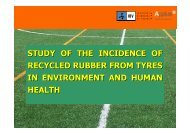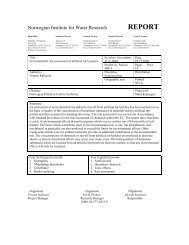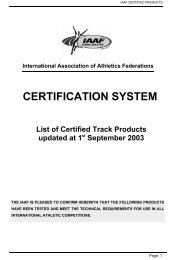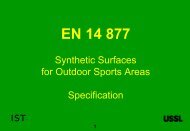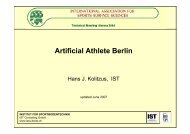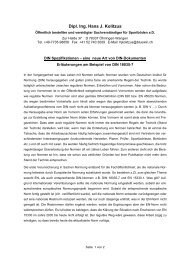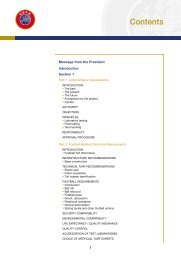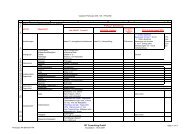Working Group - International Association for Sports Surface Sciences
Working Group - International Association for Sports Surface Sciences
Working Group - International Association for Sports Surface Sciences
You also want an ePaper? Increase the reach of your titles
YUMPU automatically turns print PDFs into web optimized ePapers that Google loves.
ISSS role in assisting UEFA in drafting its Manual <strong>for</strong> Artificial Turf <strong>Surface</strong>s <strong>for</strong><br />
UEFA Competitions<br />
Establishment of the working group<br />
UEFA, at the 2001 ISSS AGM, asked the ISSS if it would be willing to assist UEFA in<br />
the drafting of test methods <strong>for</strong> inclusion in the specification it was in the process of<br />
preparing <strong>for</strong> artificial turf surfaces <strong>for</strong> use in UEFA competitions.<br />
The ISSS Chair tabled a motion, which was passed at the AGM, that the ISSS<br />
establish a small working group to work with UEFA and that the group comprise:<br />
Dominique Boisnard of Labosport SARL, France (Scientific Member and member of<br />
CEN Technical Committee TC 217)<br />
Alastair Cox of Centre <strong>for</strong> <strong>Sports</strong> Technology, United Kingdom (Scientific Member<br />
and member of CEN Technical Committee TC 217)<br />
Juan Dura of Institut de Biomechanica de Valencia, Spain (Scientific Member and<br />
member of CEN Technical Committee TC 217)<br />
Hans-Jorg Kolitzus of Institut für Sportbodentechnik, Switzerland (Scientific Member<br />
and member of ISSS board)<br />
Preparation of the UEFA manual – role of the ISSS<br />
Prior to approaching the ISSS UEFA, and their consultant Rolf Hediger of STS<br />
Sportfloor Technology Service (ISSS Individual Member) had commissioned a series<br />
of tests on natural turf and artificial turf surfaces. These tests were undertaken by<br />
several Scientific Members of the ISSS and the data generated by them <strong>for</strong>ms the<br />
basis of the UEFA requirements <strong>for</strong> artificial grass surfaces. The task of the ISSS<br />
working group was there<strong>for</strong>e to prepare scientifically precise test methods that would<br />
ensure levels of reproducibility and repeatability that are appropriate <strong>for</strong> the<br />
properties being measured and the intended use of the artificial turf surfaces at the<br />
highest levels of professional club football. The working group’s role did not include<br />
the establishment of UEFA’s requirements or the selection of the parameters to be<br />
measured.<br />
During 2002 the working group met three times, once by itself and twice with UEFA.<br />
All other discussions took place electronically. Initial draft test methods <strong>for</strong> each<br />
parameter selected by UEFA were prepared and following review and approval by<br />
the working group these were submitted to UEFA <strong>for</strong> comment. Following review by<br />
UEFA and a meeting with the ISSS working group UEFA, via their consultant,<br />
incorporated the tests methods into the UEFA draft manual as Part 2 Section 2. The<br />
entire draft manual was then issued by UEFA <strong>for</strong> comment to all interested bodies<br />
that had previously expressed an interest to UEFA in their work. The bodies<br />
consulted included ISSS scientific members, national football associations,<br />
manufacturers and contractors.<br />
All comments relating to test methods were collated by UEFA and referred to the<br />
ISSS working group <strong>for</strong> review and assessment. The ISSS working group prepared<br />
a paper detailing its appraisal of each comment and presented these at a meeting<br />
with UEFA to allow UEFA to assess the validity or otherwise of the comment / ISSS<br />
view.<br />
Following review the final draft of the UEFA manual was prepared and circulated <strong>for</strong><br />
editorial approval. The first edition of the manual was published by UEFA in
November 2002 and presented to the sports surfacing industry at the 2002 ISSS<br />
technical conference held at UEFA’s headquarters at Nyon, Switzerland.<br />
The UEFA manual may be downloaded from UEFA’s website at<br />
http://www.uefa.com/Uefa/index.html<br />
Conclusion of ISSS – UEFA working group<br />
The publication of the manual concluded the role of the ISSS working group and<br />
UEFA <strong>for</strong>mally notified its members of its thanks <strong>for</strong> the work undertaken and the<br />
positive outcome of the partnership between UEFA and the ISSS. UEFA also stated<br />
that whilst it would wish to retain a close relationship with the ISSS it was<br />
establishing an UEFA Expert’s Panel <strong>for</strong> artificial turf surfaces, to advise the UEFA<br />
Executive Committee during its two year programme of monitoring artificial turf<br />
pitches, including the five pilot pitches part funded by UEFA.<br />
UEFA Expert’s Panel<br />
The size of an UEFA Expert’s Panel is limited by UEFA’s constitution to up to eleven<br />
members, all of whom have to be endorsed by the national football association of the<br />
country in which the member is based. The UEFA Expert’s Panel <strong>for</strong> Artificial Turf<br />
comprises representatives from national football associations and clubs (5), UEFA’s<br />
Medical Committee (2) sports bio-mechanics (1), sports surface test houses (2) and<br />
UEFA’s external consultant. Four of the members are also members of the ISSS<br />
helping to ensure the link between UEFA and the ISSS is maintained.<br />
Assessment of the role of the ISSS in working with UEFA<br />
Overall the role of the ISSS and its working group can be seen as very positive;<br />
UEFA has established a set of detailed test procedures in less than twelve months,<br />
whereas CEN has failed to achieve a similar goal in twelve years; the publication of<br />
detailed test procedures has been welcomed by a number of national football<br />
associations who have adopted them <strong>for</strong> use in the own national standards <strong>for</strong><br />
community use artificial grass football pitches; manufacturers are generally happy<br />
that there is finally a set of test methods that avoid discrepancies between<br />
laboratories; an ongoing relationship has been established between UEFA, one of<br />
the worlds most influential and powerful sports governing bodies and the ISSS; the<br />
ISSS profile within the sports surfacing industry has been raised.<br />
Whilst a small number of ISSS members may feel they were placed at a commercial<br />
disadvantage by not having prior knowledge of the final document prior to<br />
publication, this is almost inevitable when a working group is established. To try and<br />
minimise such concerns it is recommended that any future ISSS working groups post<br />
updates of its work on the ISSS web site (members only section to retain<br />
confidentiality of the ISSS partner). It should, however, be noted that the members of<br />
the working group undertook their work at no cost to the ISSS and the ISSS made no<br />
charge to UEFA. Whilst possibly creating greater transparency within the ISSS the<br />
organisation needs to be careful that it does not impose unrealistic demands on the<br />
time and resources of the members agreeing to represent it, or budget <strong>for</strong><br />
remunerating members <strong>for</strong> their time and expenses.<br />
Alastair L Cox<br />
CST
7 th January 2004



